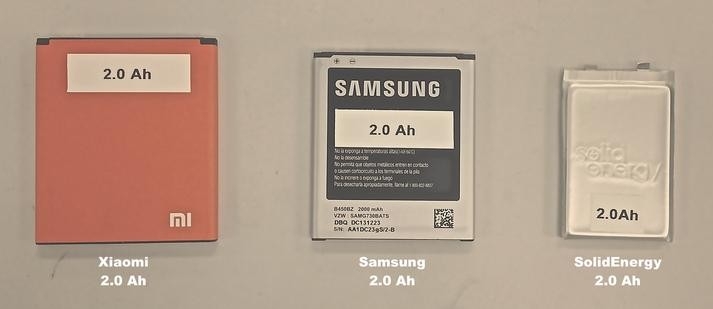
The buddies who have seen the disassemble diagram of the iPhone may all know that the battery occupies a considerable part of the internal space of the mobile phone. In fact, more than Apple, other mobile phone manufacturers in order to ensure the phone's thin texture, also have to make a choice: either sacrifice the standby time, compress the battery capacity, or reduce the number of components, use more lightweight and compact components, this To a large extent, the current industrial design of the mobile phone industry. Now scientists from the MIT Energy Laboratory intend to change this situation.
According to a recent report from MIT News, a new "lithium metal" technology can double the number of ions originally present in a lithium-ion battery while keeping the battery's volume inconvenient, and then double the amount of electricity, or you can choose to With the same amount of electricity, the volume of the battery will be reduced by a factor of two. Regardless of which approach described above, the current battery industry will be largely subverted.
The technology comes from Solid Energy Systems, a company owned by MIT Energy Labs. Qichao Hu, founder and CEO of the company, said in an interview: “This is a monument to the battery industry.â€
Technical principleIn a typical lithium ion battery, an oxide of a lithium metal lithium alloy is generally used as a positive electrode material, graphite is a negative electrode material, and a non-aqueous electrolyte generates a chemical reaction together. There are many optional positive electrode materials, and lithium iron phosphate is widely used in mainstream products. Due to the good conductivity of graphite itself and the stability of its own chemical properties, it does not undergo an additional chemical reaction with the electrolyte solution and is therefore widely used as a negative electrode material. When the battery is working, the directional movement of the electrons is generated by the complementary chemical reactions on the positive and negative electrodes, thereby providing power to mobile phones and other devices.
However, graphite, which is usually the best anode material, also has its limitations. Although graphite can conduct electricity, it is not a metal after all. Therefore, the limited number of ions inside it becomes the biggest disadvantage. Scientists have always wanted to replace graphite with lithium metal because it can hold more ions.
Rechargeable lithium metal batteries that first appeared in 1996 were developed based on this idea. In the lithium metal battery at that time, manganese dioxide was generally used as a positive electrode material, metal lithium or an alloy thereof was a negative electrode material, and a nonaqueous electrolyte solution was also used in the reaction. However, due to the chemical nature of metals such as lithium, which are not stabilized by graphite, they generate additional chemical reactions with the electrolyte, causing various types of mixtures to contaminate the electrolyte, thereby greatly reducing the charge life, making lithium metal batteries almost non-reusable. Products. In addition, this reaction generates large amounts of heat at the same time , possibly igniting the electrolyte and causing an explosion. With the high technical requirements of lithium metal batteries, it has not been popularized. At present, only a few countries in the world are producing such lithium metal batteries.
However, SolidEnergy Systems' new lithium-metal battery overcomes these problems and they have developed a new solid-liquid hybrid solution. In order to prevent reaction with the traditional electrolyte solution, they wrapped a thin layer of solid conductive material on the surface of lithium metal, then chemically reform the traditional electrolyte , reduce its activity under the premise of ensuring the conductivity, and redesign. The battery structure improves the material of the isolation layer between the positive and negative electrodes, so that the lithium metal can not generate an additional chemical reaction with the electrolyte while ensuring the ion carrying amount. While ensuring that charging and safety can be repeated, the battery power has also been doubled.
More crucially, this new type of lithium metal battery is produced in the existing lithium-ion battery factory, which makes the technology has a very wide range of application prospects.

At present, the company has announced application plans in related fields. In 2017, they will supply this new type of battery to smartphones and wearables. In 2018, they will provide new batteries to EV manufacturers. However, as early as this November, they intend to provide the technology to some unmanned manufacturers first.
Hu Qichao said: "At present, many companies have used drones and hot air balloons to bring free Internet access services to a large number of developing countries, as well as rescue services for sudden disasters. I think this is very important. It is also a very proud cause, so we plan to help these companies improve the battery life in November this year."
The application of this technology in the field of electric vehicles is indeed full of expectations. Hu Qichao said: “The current industry standard for electric vehicles is to drive at least 200 miles (about 320 kilometers) after each charge. Our technology can reduce battery size and weight by half, while maintaining the same mileage, so guarantees With the same battery size, our technology allows future electric cars to drive at least 400 miles after a single charge."
Today, with the rapid changes in technology, we can feel the subtle changes in the world almost every day. Solid Energy Systems' new battery is one of them. With their technology, mobile phones, wearables, electric vehicles, and drones, all of which use rechargeable batteries, are likely to undergo even greater changes in the future. We are looking forward to this.
Related Reading:
Musk said to give your home a roof, and the builder’s rice bowl should also be grabbed?
US scientists invented a transient battery: 30 minutes to dissolve in water
Nissan Motors will sell electric vehicle battery business, Chinese companies intend to sell